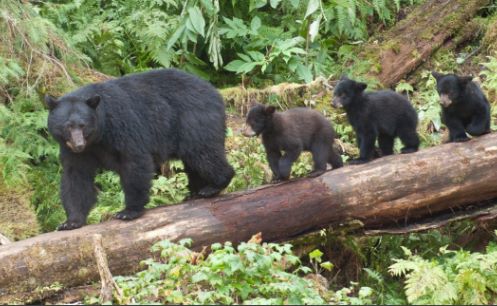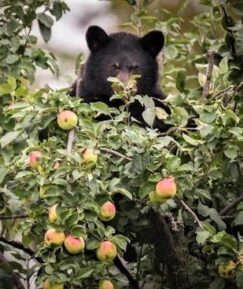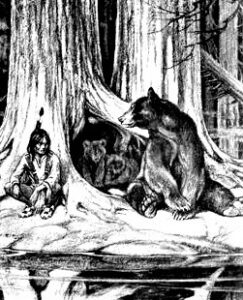Living with Bears…
WE LOVE BEARS!

They shamble through the woods that surround our ol’ farmstead. Even had a bear cub or two raid our ancient apple trees. And they’re welcome to ’em. Just as the deer are welcome to the fallen apples in the autumn grass.
So far, we — those bears and this human family — have held our Truce.
The Civilized Bears are coming, it’s true, but not all of those wild black and brown shamblers out there understand truces. Admire ’em — but watch ’em!
We don’t deliberately feed the bears.
Here’s a Guest Blog from Judy Michaud, a woman who knows her stuff. She’s from Highlands, North Carolina. Bear Country.
Living with Bears: “People, as well as bears, are moving to Western North Carolina at a rapid pace.”
 WE are the newcomers to these mountains. Up here on the Highlands-Cashiers plateau, we do live among a very large population of Black Bears, who have roamed these mountains for ages.
WE are the newcomers to these mountains. Up here on the Highlands-Cashiers plateau, we do live among a very large population of Black Bears, who have roamed these mountains for ages.
The Black Bear is the only species of bear living in the mountains of Western North Carolina.
In the past 20 years, the range of the Black Bear in North Carolina has expanded to over 9 million acres which includes the coastal area as well as the mountains.
We must accept Living with Bears.
Many people have reported sightings of black bears in their yards, raiding garbage cans, birdfeeders, and crossing roads. By learning more about these gentle creatures as well as preventative measures, we all can co-exist peacefully. If these preventative measures are not learned, the bear becomes a nuisance bear.
LIVING WITH BEARS: WHAT IS A NUISANCE BEAR???
A bear is considered a nuisance when it learns to find and gets used to eating human food. Finding this food either from garbage where people live or recreate or camp sites bears become accustomed to the ease of finding human food. This bear must be captured and relocated to another area or euthanized to prevent them from becoming an increased danger to people. You can protect yourself, family and belongings AND bears by learning how to live with bears and other wildlife.
Black Bears are the largest mammals living in the forest of North Carolina. The average weight is 150-350 pounds, but a few bears over 600 pounds have been reported. Bears are omnivorous (as are humans), eating a wide variety of foods such as plants, berries, acorns, other nuts, insects, fruit, as well as some animal material. Black Bears are usually shy and try to avoid human contact and are not normally aggressive toward people.
So as the population of both bears and humans increase in our area, we must learn to co-exist. Don’t let your ignorance or carelessness cause the unnecessary death of a bear!
LIVING WITH BEARS: BEAR ENCOUNTERS — SEEING AND AVOIDING BEARS
If you spend much time outdoors in Western North Carolina either hiking, visiting waterfalls, fishing or nature walking the chances of encountering a black bear are very good. Watching bears in their natural environment from a safe, respectable distance is very exhilarating.
Positive experiences by visitors and residents of The Highlands Plateau are far more common than negative. Although extremely rare, meeting an aggressive bear sometimes occurs. The following are some tips to avoid them.
- Hiking in a group and during daylight hours.
- Be aware. Learn about and watch for bear signs.
- Overturned rocks or broken up rotten logs (bears foraging for grubs or insects). Claw marks on trees. Tracks in the dirt or snow. Berries on the ground, plant root diggings, fur on the bark of trees.
- Stay away from food sources (wild berry patches, or fruit trees with fruit on the ground) and dead animals — bears may be foraging in the area or protecting a carcass.
Living with Bears requires caution. If you see a bear, remain watchful.
DO NOT approach it. If your presence causes the bear to change its behavior (stops feeding, looks at you, changes its travel direction) YOU ARE TOO CLOSE!! Don’t run away, just back away slowly, watching the bear.
If the bear starts running toward you, making loud noises or swatting the ground, he is signaling that he needs more space. Try to increase the distance between you and the bear. The bear will probably do the same. If it comes toward you without the paw swatting and loud noises and continues to follow you. Make yourself look as large as possible. Throw NON-Food objects such as rocks at the bear. Use a deterrent such as a stout stick. Do not run and don’t turn away from the bear. Don’t leave food for the bear; this encourages further problems.
“Most injuries from a Black Bear attack…”
Most injuries from a Black Bear attack are minor as a rule from a bear attempting to get at food. If the bear’s behavior indicated that it is after your food, and you are physically attacked, separate yourself from the food and slowly back away.
If the bear does not show interest in your food, fight back aggressively with any available object — the bear may consider you prey!
Not all bears are Gentle Ben.
 “THE BOY WHO WAS RAISED BY BEARS!” A NATIVE CANADIAN MI’KMAQ STORY RETOLD & FREE TO READ…
“THE BOY WHO WAS RAISED BY BEARS!” A NATIVE CANADIAN MI’KMAQ STORY RETOLD & FREE TO READ…
“In the Old Time, before the coming of foreign seafarers and clamoring machines and civilized greed, when the forests were greener and the trees were bigger, there lived a Mi’kmaq boy named Mikinawk…”
Here’s one of my most popular bear stories!
To read it now go to MUINEJ THE BEAR’S CUB – A Mi’kmaq Bear Story Retold.
Living with Bears: TRUE or FALSE?
1. A bear that stands on its hind legs is preparing to charge.
FALSE: A bear that is standing on its hind legs is usually trying to identify you by scent or sight. Bears rarely attack, but when they do it is on all fours with their head down.
2. A bear’s sense of smell is better than a dog’s.
TRUE: In fact, it is one of the most sensitive noses in the animal world.
3. Bears are naturally aggressive towards humans.
FALSE: Bears are shy, retiring creatures who only act aggressively as a last resort – usually when they feel threatened.
4. The best way to get away from an aggressive bear is by running.
FALSE: Bears can run as fast as a racehorse for short distances and running might trigger their chase response.
5. Bears cannot run downhill.
FALSE: Bears can run faster than any human – in any direction.
For more information you can contact the Appalachian Bear Center. The Nature Center in Highlands is also a great source for more information on Bears in Highlands and Cashiers
Remember, bears are far more likely to enhance your wilderness experience than spoil it. Learning how to interpret their behavior and act responsibly is part of the thrill of sharing the mountain with these wild amazing creatures.
Living with Bears at your mountain home or rental property:
- If you feed your pet outside, make sure you bring in the food and dish at night.
- Bring in your bird feeders at night or empty them nightly (bears love the black oily sunflower seeds)
- Keep your garbage cans inside a building or shed until pick-up day. If you have particularly odorous food scraps such as fish and/or meat bones, freeze before the day of your garbage pick up.
- Put out your garbage out only a couple of hours before pick up not the night before.
- If you are going out of town, haul your garbage to the dump. Do not leave until pick up day.
* NEVER TRY TO FEED A BEAR — a FED Bear is a DEAD Bear
Do not feed the bears. If a bear comes into your yard, just watch it from a window and realize how lucky you are to be able to see such a majestic animal so close. The bear is a wild animal and he needs to be treated like a wild animal.
Guest Blog post by Judy Michaud. Judy began her real estate career in the sleepy hamlet of Highlands, North Carolina. She’s finely honed her craft and has become one of the top broker/agents in that bustling arena. To find out more about Judy visit meadowsmountainrealty.com/judy-michaud/.
Bears have a history.
Some of that history, when it comes to humans, involves situations that get up close and personal. So you get headlines like: “A grizzly bear has killed a hiker at Denali National Park, Alaska — the first fatal attack in the park’s history, officials said Saturday.”
People remember lines like “Initial evidence indicates that the attack occurred proximate to the river’s open braided gravel bar, although the bear subsequently dragged the remains to a more secluded, brushy cache site.” But forget “Officials said this attack was the first known fatal mauling in the park’s history.”
Just remember: not all bears are Gentle Ben.
“Live Free, Mon Ami!” – Brian Alan Burhoe
Updated June 12, 2020
Living With Bears in Highlands, North Carolina – Bear Encounters
Alaska grizzly attack, bear encounters, bear kills hiker, civilized bears, gentle ben, grizzly attack.












